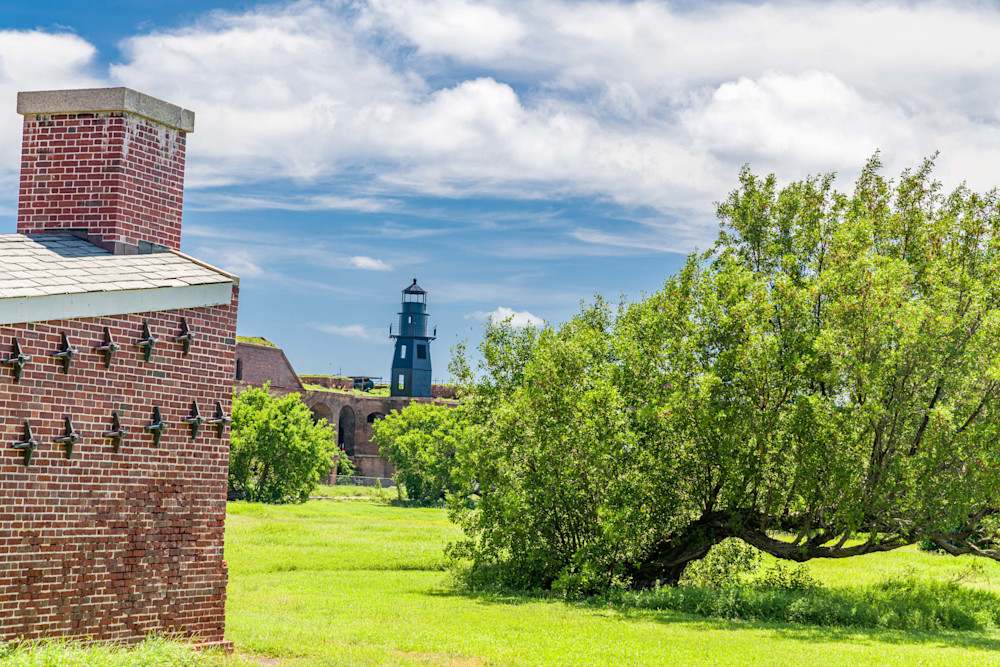Exploring the interior grounds of Fort Jefferson in the Dry Tortugas is a journey into the past, where the remnants of a 19th-century military outpost blend with the tropical surroundings. Here's a descriptive portrayal of what you might encounter within the interior grounds:
**Courtyards and Parade Ground:**
- **Open Courtyards:** The interior grounds feature open courtyards with well-tended greenery. These spaces serve as focal points within the fort, providing a sense of openness amid the formidable walls.
- **Parade Ground:** The main parade ground, a central and expansive area, may be surrounded by officer quarters, barracks, and other fort structures. This flat, open space historically served for military drills, ceremonies, and assembly.
**Historical Structures:**
- **Officer Quarters:** Along the edges of the parade ground, you'll find the remains of officer quarters, characterized by solid construction and possibly featuring arched verandas. These structures reflect the hierarchy and living conditions of military personnel.
- **Barracks:** Rows of barracks line the courtyard, showcasing where enlisted soldiers once lived. The barracks, typically two stories high, may have simple, functional architecture.
- **Storehouses and Workshops:** Adjacent to the parade ground, storehouses and workshops stand as reminders of the logistical support required to sustain the fort. These structures may have large doors for loading and unloading supplies.
**Vegetation and Tropical Flora:**
- **Palm Trees:** Tall palm trees sway gently in the breeze, creating a tropical ambiance within the fort's confines. Their fronds cast dappled shadows on the ground.
- **Sea Grapes and Coastal Plants:** Low-growing sea grapes and other coastal plants may dot the landscape, adding splashes of greenery to the historical setting.
**Well and Water Cisterns:**
- **Historical Well:** A well, often centrally located, provides insight into the fort's water supply. Its construction may be marked by a pulley system, and the surrounding area could feature remnants of the original well structure.
- **Cisterns:** In addition to wells, cisterns designed to collect rainwater might be present. These features showcase the fort's ingenuity in managing essential resources.
**Defensive Features:**
- **Ramparts and Walls:** Elevated walkways along the fort's walls, known as ramparts, allow for panoramic views of the surroundings. Soldiers once patrolled these walkways, keeping a watchful eye on the sea.
- **Embrasures and Gun Ports:** Embrasures and gun ports, strategically positioned in the walls, provide a glimpse into the fort's defensive capabilities. These openings once housed cannons aimed at potential maritime threats.
**Interpretive Displays:**
- **Educational Signage:** Throughout the interior grounds, interpretive displays and historical signage offer information about the fort's construction, historical events, and the lives of those who lived and served there.
**Emotional Essence:**
- **Silent Narratives:** The interior grounds carry a silent narrative of the fort's history. The combination of historical structures, tropical flora, and the sea breeze creates an atmospheric blend of the past and the present.
**Visitor Experience:**
- **Immersive Exploration:** Visitors are encouraged to explore the interior grounds at their own pace, immersing themselves in the history and unique atmosphere of Fort Jefferson. The well-preserved and weathered structures offer tangible connections to the fort's storied past.
















